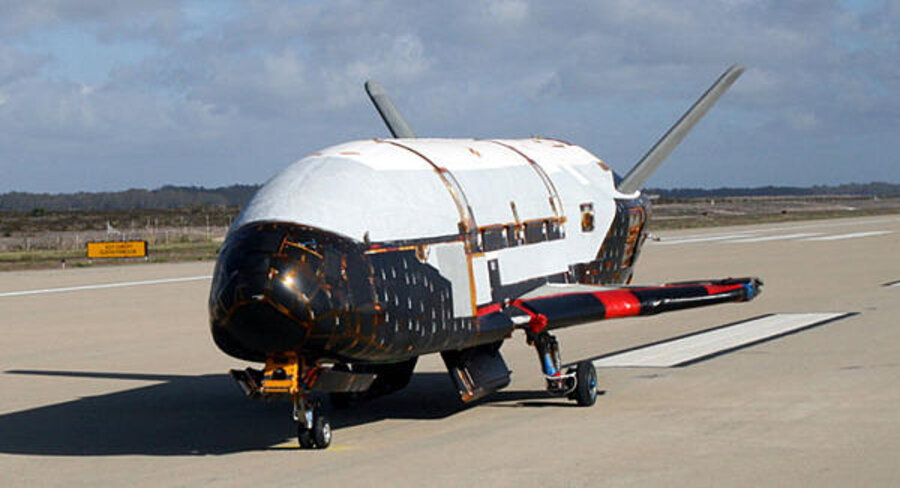Get ready to rumble: Air Force mystery spaceship X-37B to launch today
Loading...
The United States Air Force's novel robotic X-37B space plane is tucked inside the bulbous nose cone of an unmanned rocket and poised for an evening blastoff from Florida tonight on a mission shrouded in secrecy.
The spacecraft, called the Orbital Test Vehicle, is poised to launch atop an Atlas 5 rocket from a seaside pad at the Cape Canaveral Air Force Station in Florida. Liftoff is slated for sometime during a nine-minute window that opens at 7:52 p.m. EDT (2352 GMT).
There's an 80 percent chance of good weather to launch the X-37B space plane. But what it will actually do in space and when it will autonomously fly itself back down to Earth remain a mystery.
IN PICTURES: The X-37 space plane
The Air Force would like to keep it that way. At least for now.
"Well, you can't hide a space launch, so at some point extra security doesn't do you any good," said Gary Payton, Air Force deputy under secretary for space systems, in a Tuesday teleconference with reporters. [X-37B spacecraft photos.]
"On this flight the main thing we want to emphasize is the vehicle itself, not really, what's going on in the on-orbit phase because the vehicle itself is the piece of news here," Payton said.
Secrets of the X-37B
The on-orbit tests, Payton said, are classified like many Air Force projects in space to protect the nature of the X-37B's "actual experimental payloads."
But the X-37B is designed to stay in space on missions that last up to 270 days long.
For this first test flight, the Air Force wants to see if the X-37B, which resembles a miniature space shuttle, can actually launch into space, open its payload bay and deploy a set of solar panels to keep it powered for months at a time. This demonstration flight is also aimed at testing the X-37B spacecraft's ability to fly itself back to Earth and land on a runway at the Vandenberg Air Force Base in California.
The key question for the Air Force: How expensive and how much work will it be to turn the X-37B spaceship around for a second flight? If the answer is "too long and too much" it may affect when the X-37B and its sister ship – a second Orbital Test Vehicle already contracted by the Air Force – fly again, if ever.
"If that's the case, it makes this vehicle much less attractive to the future," Payton said.
Currently, the Air Force envisions launching the second X-37B, presumably the Orbital Test Vehicle 2, sometime in 2011.
X-37B's long legacy
The X-37B Orbital Test Vehicle 1 was built by Boeing's Phantom Works division in Seal Beach, Calif. It is about 29 feet (9 meters) long and has a wingspan of just over 14 feet (4 meters) across. It stands just over 9 1/2 feet (3 meters) tall and weighs nearly 11,000 pounds (4,989 kg).
This SPACE.com X-37B graphic illustrates some details of the space plane and its relative size.
When compared to NASA space shuttles, which can weigh around 100 tons when fully fueled and loaded with cargo, the X-37B seems like a diminutive cousin. NASA space shuttles are 122 feet (37 meters) long and have 78-foot (24-meter) wingspans.
The X-37B has a small payload bay about the size of a pickup truck bed. Each NASA space shuttle has a 60-foot (18-meter) payload bay that can fit a large bus inside.
But Payton described the X-37B as "one generation beyond the shuttle."
Instead of the space shuttle's fuel cells to generate power, which need a supply of liquid hydrogen and oxygen, the X-37B has a solar array and lithium ion batteries. It does not have a robotic arm, but may in the future be capable of rendezvousing with satellites or retrieving them from orbit.
The spacecraft was actually dreamed up by NASA in 1999 as a way of testing new technologies for reusable spacecraft. NASA passed the project off to the Defense Advanced Research Project Agency (DARPA) in 2004, when funding dried up. The program changed hands again in 2006. That's when the Air Force took over.
"After a tumultuous history of sponsorship, it's great to see the X-37B get to the launch pad and get to space," Payton said.
When it's mission is over, Air Force flight controllers plan to send the X-37B prototype the re-entry order and then hope that it successfully flies itself through Earth's atmosphere and lands safely at Vandenberg. Edwards Air Force Base in California's Mojave Desert is the backup landing site, Payton said.
But when that re-entry and landing occurs is anyone's guess, even within the Air Force.
"In all honesty, we don't know when it's coming back for sure," Payton said. "It depends on the progress we make with the on-orbit experiments and the on-orbit demonstrations."





